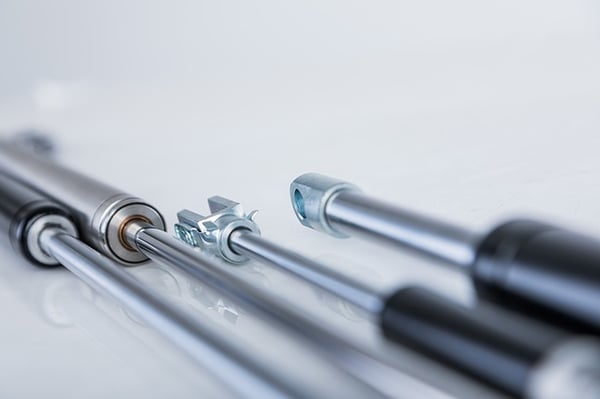
When it comes to weight and motion control, developers certainly have their options. Two of the most popular options in high-stress, high-performance applications are gas springs and counterbalance spring hinges. Like with many other competing technologies, there’s a debate over which is the better value.
Since we use both in our motion control solutions, we thought we’d give our expert, (mostly) unbiased opinion on the debate.
Disclaimer: Different types of hinges make sense for different applications. With that in mind, the following should help you decide whether a heavy-duty gas spring or a heavy-duty, spring-assisted counterbalance hinge best fits your budget.
The Difference Between Heavy-Duty Gas Springs and Spring-Assisted Hinges
Though both motion control mechanisms achieve the same results – making moving an object, say, a lid, easier – there are distinct differences between the two.
Let’s take a look at the differences between counterbalance vs gas springs, starting with the latter.
Gas Spring Vs. Gas Strut (& More)
So, how do gas springs work?
Unlike counterbalances, they rely on gas and oil to compress and dampen a force.
Because the terms surrounding gas springs are constantly mixed up and used interchangeably, let’s quickly review the difference between a gas spring, gas strut, and gas shock:
- Gas springs (also called gas cylinder springs): These possess far greater forces than struts and, usually, much shorter strokes. They don’t offer any type of motion control or dampening. Much like a simple mechanical compression spring, when uncompressed gas springs don’t control speed.
- Gas spring dampers (also called gas shocks): Damped gas springs support moving objects while controlling the system’s motion so it doesn’t slam down.
Gas struts (also called compression gas springs): Gas pressure inside the strut pushes or pulls, depending on the configuration. These also feature a dampening circuit, typically to control the speed of motion through one or both directions of travel.
Counterbalance Spring
A counterbalancing system uses various types of mechanical springs to take the effort out of lifting and supporting a lid, countertop, cover, or electromechanical equipment. It’s not just the springs themselves - it’s how an engineer applies geometry and other techniques to support the lid.
The system counteracts the weight of the lid and balances it in a way that controls how much force the user “feels” and whether it stays suspended when the user lets go.
Pros & Cons of Gas Springs
Gas springs are often saved for more specialized applications, such as:
- Airplane overhead bins
- Armored vehicle doors
- Release hatches
- Cargo doors
- Hospital bed rail systems
- ATMs
- Gaming machines
Pros
- The up-front cost is lower in many cases. The costs are also a little less volatile in terms of a simple gas spring vs. a more complex one.
Cons
- Shelf life is hard to predict. Gas springs likely won't last as long as counterbalance systems. That's because their shelf life is dictated largely based on what application they're working inside. Some springs will lose a little bit of their performance every year until they need to be replaced. On higher-end applications, it's common for manufacturers to offer 15-year warranties on the springs.
- They deteriorate faster in extreme conditions. There’s a limit to how well gas springs can hold up in hot or cold applications. If you use a gas spring in an application that’s not ideal, you’ll be shipping out replacement parts sooner rather than later.
- There’s a risk of explosion. The higher the temperature a gas spring is exposed to, the higher its internal pressure becomes. Put it this way: If you put one inside a grill, it’s going to explode. Then you’re not only providing a replacement part, you’re also spending time and money on a redesign.
- They’re hard to recycle. To recycle a gas spring, you have to drill a hole in it (not fun), take it apart because you can’t recycle the whole thing, and so on. There’s a whole messy procedure with recycling gas springs.
- You can’t adjust it midlife. Got wear and tear on your gas spring? Too bad - you’re stuck with it unless you want to totally replace it.
- Lawsuits are expensive. Gas springs sometimes leak. In certain applications, like medical or food industries, that can invite a lawsuit. There’s a reason we’ve replaced clients’ $12 gas springs with $1,000 counterbalances - it’s still cheaper than the alternative. Note that today there are special, food-safe oils that gas springs can use, but they’re very high-cost.
Pros & Cons of Counterbalances
These mechanical springs are able to support heavy lids, covers, surfaces, and other equipment with little to no strain for the user. Fitting to the name, counterbalance spring systems work to offset the weight of the appliance so that they're able to be opened with great ease and shut safely.
You'll find counterbalance hinges in a lot of commercial or household appliances, such as:
- Oven doors
- Car hatchbacks
- Garage doors
- Cryogenic freezers
- Tanning beds
- Heavy-duty grills (for the serious grillmaster!)
Pros
- They can last over 250,000 cycles. Think about something like an oven, and then think about how many times you open and close the door each week, month, and year. The wear is exponentially higher on a commercial appliance. That's maybe the greatest benefit of counterbalance systems — they last for ages despite heavy use.
- Safety is a trademark. Counterbalance systems don't just help people easily lift lids, they also allow this to happen in a safe way over 1,000 cycles. Many companies have come to a hinge design company for help because their old design has caused a lawsuit.
- They excel in extreme temperatures and conditions. Counterbalances work well even in demanding products and environments, like cryogenic freezers. You don’t have to worry about heat or cold sapping the lifetime value of the product.
- They’re field-adjustable. If the situation changes or your hinge has wear and tear, no big deal. You can fine-tune it throughout its life.
Cons
- The range of prices is steep. Because they’re a little more complex in makeup and require design skills than other types of springs, heavy-duty spring hinges also cost a little bit more. Depending on how sturdy a hinge you need, you’ll potentially pay anywhere from $50 to $1,000 per unit.
- Dampening isn’t free. Since a counterbalance doesn’t naturally dampen, you’ll have to add a secondary damper to the design if you want one.
Should You Be Switching?
When gas springs fail, they fail dramatically. On the other hand, they’re cheaper up-front.
Though more expensive, counterbalance spring systems provide a high level of functionality and a long useful life.
So, which type of product would be best for your application? Make sure you carefully assess your application and what you want from a motion control mechanism. If there’s any way you can fit a counterbalance in your budget, it’s almost always the better option.
Editor's Note: This blog post was originally published on June 6, 2019, and was updated to reflect changes in information.
.png?width=12000&height=2033&name=WeberKnappLogo_white%20(1).png)


